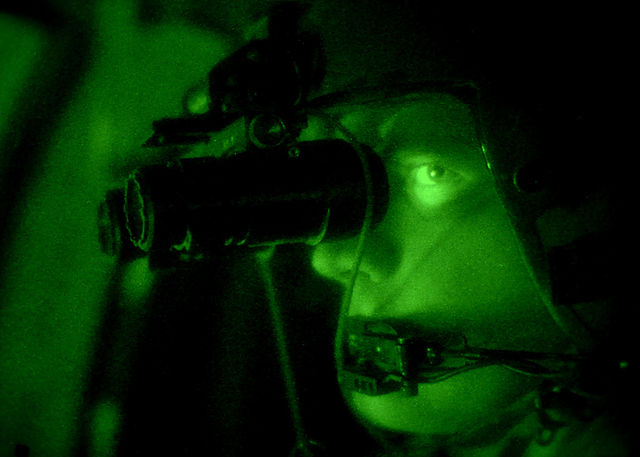
How do night vision goggles work? There are two types: the old style and the new style. The old-style goggles work by detecting and enhancing infrared light. The newer ones work by digitally enhancing the image.
We cannot see well in the dark. Our eyes work by collecting reflected light radiation and transmitting it to our brains as an electronic signal. We have cones in our eyes that detect different wavelengths. We have cones to detect short wavelengths, medium wavelengths, and long wavelengths. We see these as the colors red, green, and blue. Our brain works out how much of each wavelength there is to work out all of the colors that are a mix of red, green, and blue. We cannot see well at night because there is not enough reflected light reaching our eyes. For night vision, we have rods. They can be activated by fewer light photons than the cones, but they cannot detect colors.
Our night vision is pretty bad when compared to a lot of animals. Cats can see far better at night than we can. We can see better in the daylight than they can, which just goes to show how both of our species have evolved. We hunt in the daytime and cats hunt at night. Owls have the best night vision of any animal. They have such great night vision because they have very large eyes and pupils, which means more light can reach their eyes. They also have five times more rods than we do, which means their eyes are very sensitive to low light. Finally, they have a reflective mirror at the back of their eyes called a tapetum lucidum, which reflects any light that misses the rods back into the eye. This is why cats and other animals’ eyes glow at night.
We can see in the dark by using night vision goggles. The early form of goggles are the ones that have a grainy green image. They work by picking up the available light and amplifying it to the point where we can see it. Even on the darkest of nights, there is still light, just not enough for us to pick up. Night vision goggles use optical lenses to focus this light. They pick up all of the light in the visible spectrum and also infrared light. The light photons pass through the lens and go into an image-intensifier tube, which is an electronic vacuum tube. The vacuum tube has two sections. The first section converts all of the photons into electrons. The second section multiples the number of electrons, increasing the power of the electronic signal. The electrons fly out of the vacuum tube and collide with a phosphor-coated screen. The phosphors absorb the energy from the electrons and convert it into light, making a grainy image. It is not possible to make a color image this way because the color comes from the wavelength of the light, and this is changed when the light is converted into electrons. The image is basically black and white. We think of night vision goggles as being green, but this is because the color green was chosen after experimentation. It turns out we can see the color green more easily than other colors.
Modern night vision goggles don’t use this method. They work in a similar way to a digital camera. Whatever light is available enters the front of the camera and is converted into a digital signal by a sensor. The sensor has a grid of photodetectors, usually a thin layer of silicon. When the photons hit the silicon, they are converted into electrons, but the sensor is able to tell how many photons hit exactly which part of the silicon grid. It can then convert this into an image that we can look at. With digital night vision goggles, the same principle applies, but the device has a far more sensitive sensor, which can react to lower levels of light. The device is then able to further amplify the signal received to create a very clear image. These devices are far superior to the original type of night vision goggles that worked with green phosphorous. As well as this, the price of digital night vision goggles has fallen so much that anybody can buy one. Might be worth the investment if you want to see what your cat gets up to at night. They’ll still know you’re there, though, because their sense of smell is far superior to ours as well. And this is what I learned today.
Image https://www.photometrics.com/learn/camera-basics/how-is-an-image-made
Sources
https://montgomeryvisionsource.com/2019/08/28/animal-kingdom-eyesight-olympics/
https://www.cis.rit.edu/people/faculty/montag/vandplite/pages/chap_9/ch9p1.html
https://www.wristband.com/content/the-science-behind-glow-in-dark-toys-materials/
https://www.photometrics.com/learn/camera-basics/how-is-an-image-made
